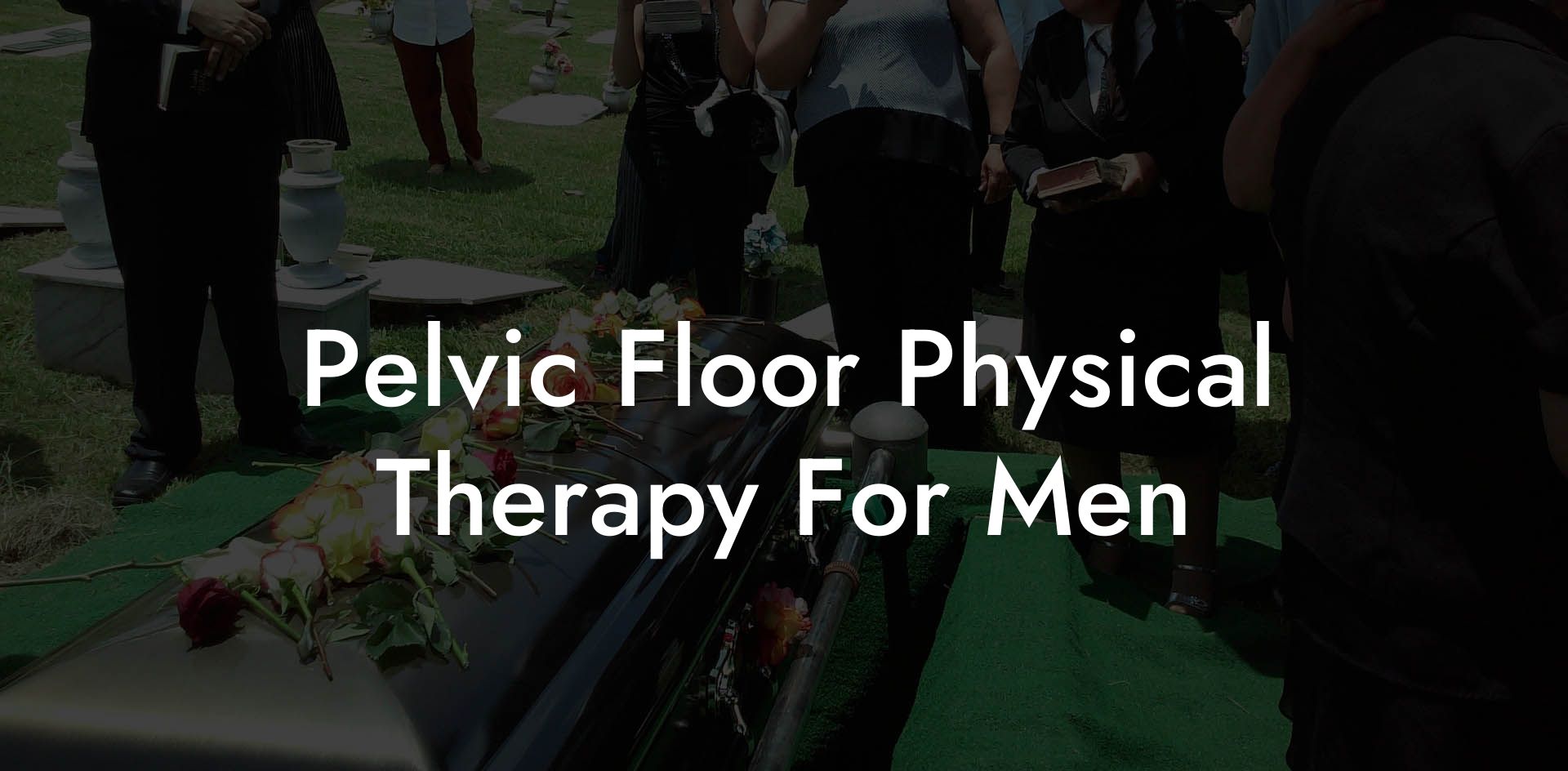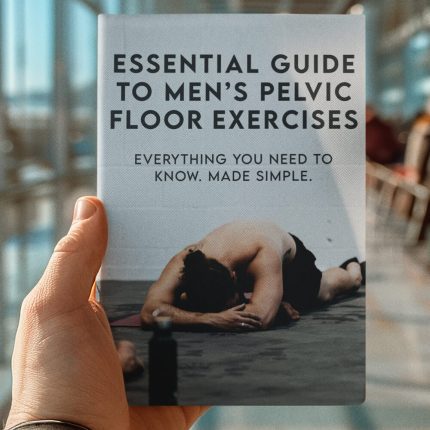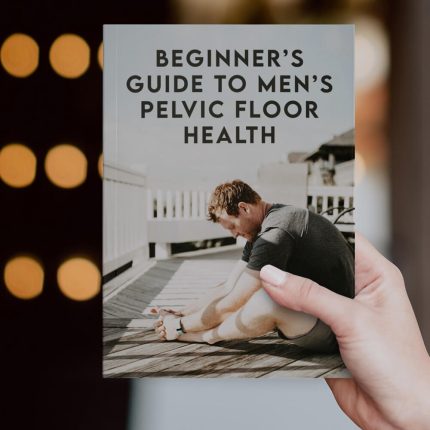
Pelvic Floor Therapy
Pelvic Floor Physical Therapy For Men

Ever thought that pelvic floor physical therapy could be a game-changer for men? It’s time to break the taboo and dive into a journey where core strength meets modern recovery techniques tailored for the male body. Whether you're dealing with incontinence, chronic pelvic pain, or simply want to boost your overall core performance, this comprehensive guide is designed to empower you with science-backed strategies, hands-on exercises, and cutting-edge therapies to help you reclaim your strength and confidence.
Quick Links to Useful Sections
- Understanding Pelvic Floor Physical Therapy for Men
- The Hidden Role of the Pelvic Floor in Men’s Health
- Common Pelvic Floor Concerns for Men
- The Science Behind Pelvic Floor Physical Therapy
- Conventional Therapies: Setting the Foundation for Recovery
- Complementary Therapies: Enhancing Recovery with a Holistic Touch
- Acupuncture
- Chiropractic Adjustments
- Massage Therapy and Myofascial Release
- Herbal and Nutritional Supplements
- Mind-Body Practices: Connecting Mental Wellness with Pelvic Health
- Mindfulness Meditation
- Deep Breathing Techniques
- Yoga and Pilates
- Pelvic Floor Exercises: Getting Down to Business
- Nutrition and Lifestyle: Fueling Your Pelvic Recovery
- Integrative Approaches: Merging Techniques for Maximum Impact
- Case Studies: Real-Life Transformations in Men’s Pelvic Health
- Case Study 1: Post-Prostatectomy Recovery
- Case Study 2: Overcoming Chronic Pelvic Pain
- Case Study 3: Enhancing Athletic Performance
- Crafting Your Personalized Pelvic Health Plan
- Resources and Community Support: Your Next Steps
- Frequently Asked Questions About Pelvic Floor Physical Therapy For Men
- Your Journey to Empowered Male Pelvic Health
Understanding Pelvic Floor Physical Therapy for Men
When most people think of pelvic floor physical therapy, images of women’s health often spring to mind. However, men face their own unique pelvic health challenges that can benefit greatly from a tailored therapeutic approach. The pelvic floor is a group of muscles, ligaments, and connective tissues that provide support for the bladder, bowel, and, yes, you guessed it, the reproductive organs. For many men, issues such as pelvic pain, post-prostatectomy incontinence, or even sexual dysfunction can arise when these muscles aren’t functioning optimally.
Pelvic floor physical therapy for men isn’t just about doing a set of generic exercises. It involves a comprehensive evaluation by a skilled therapist who understands the intricacies of male anatomy and the complexities that come with it. Whether you're an athlete looking to up your game or someone recovering from surgery, the tailored exercises and hands-on therapies developed for men can make all the difference in your recovery and long-term pelvic health.
This article is packed with practical advice that blends conventional physical therapy with modern techniques and lifestyle modifications. Expect discussions about anatomical insights, breakthrough treatments, and even some myth-busting to debunk common misconceptions about men’s pelvic health. Let’s hit the ground running as we explore everything you need to know about pelvic floor physical therapy for men.
The Hidden Role of the Pelvic Floor in Men’s Health
The pelvic floor is often an unsung hero of male health. It not only supports essential organs but also plays a critical role in sexual performance, continence, and overall core stability. For men, an optimally functioning pelvic floor muscle can enhance everything from athletic performance to everyday comfort. Yet, when these muscles become weak or tight, the consequences can range from subtle discomfort to serious issues like chronic pelvic pain syndrome (CPPS) or even post-surgical complications.
Your pelvic floor affects how you move, how you use the bathroom, and how sex feels, yet most men are never taught how it works. This essential guide explains your pelvic floor in plain language and gives you a simple plan to relax, strengthen, and look after it at home.
Youll Learn How To:
- Understand what your pelvic floor does for bladder control, posture, and sex
- Spot signs of tension, weakness, and poor coordination
- Use breathing, reverse Kegels, and classic Kegels safely
- Improve habits for sitting, lifting, sport, sleep, and stress
Whats Inside: friendly explanations, safety guidelines, daily drills, sex function tools, flare up plans, and a complete twelve week program with trackers.
Perfect For: men of all ages who want less pelvic tension, fewer leaks, better comfort on the toilet, and more confidence in movement and in the bedroom.
Many of the problems associated with an underperforming pelvic floor are linked to modern lifestyles, long hours at a desk, high levels of stress, and even certain types of athletic training that overlook pelvic strength. In men, these challenges are often compounded by factors such as aging or post-prostate surgery recovery, making a dedicated approach to pelvic floor therapy not just beneficial, but essential.
In essence, recognizing the role of the pelvic floor is the first step towards holistic wellness. By incorporating targeted exercises, manual therapies, and even mindfulness techniques, you can transform your pelvic health, improve your performance, and ultimately feel more confident in your body.
Common Pelvic Floor Concerns for Men
Men face a range of pelvic floor issues that often fly under the radar. Understanding these challenges is crucial for anyone seeking to improve their pelvic floor health or recover from an injury or surgery. Some common concerns include:
- Urinary Incontinence: Loss of bladder control isn’t just a women's issue. Many men struggle with incontinence, particularly after prostate surgery. Strengthening the pelvic muscles helps restore bladder control.
- Chronic Pelvic Pain: Chronic pain in the pelvic region, sometimes linked to tension myalgia or nerve irritation, can be debilitating. Targeted therapy techniques can break the vicious cycle of pain and muscle tension.
- Sexual Dysfunction: A weak or overly tense pelvic floor can impact sexual performance and satisfaction. Proper therapy not only enhances strength but also improves coordination during sexual activity.
- Post-Surgical Recovery: Men recovering from procedures like prostatectomy can benefit tremendously from a focused program that aids in restoring pelvic floor function.
Knowing the potential issues is the first step in addressing them. Pelvic floor physical therapy for men employs targeted exercises, manual techniques, and cutting-edge technology (such as biofeedback) to address these issues holistically. Whether it’s easing discomfort or boosting performance, the correct approach can turn frustration into renewed strength.
The Science Behind Pelvic Floor Physical Therapy
At its core, pelvic floor physical therapy relies on the principle that a strong, flexible, and well-balanced pelvic floor can fundamentally enhance overall health. Research shows that by engaging in structured exercises, both strength and coordination of the pelvic muscles can be dramatically improved. Studies targeting post-prostatectomy patients have revealed significant improvements in urinary control and a reduction in chronic pelvic pain when therapy is consistently applied.
For men, this type of therapy often involves not only exercises like Kegels (yes, guys, Kegels are for you too!) but also reverse Kegels, which help relax an overly tense pelvic floor. What differentiates male pelvic floor therapy from the typical regimented approach is the focus on individualized assessment, each man's anatomy is unique, and so is their pattern of muscle use and dysfunction.
Modern methods combine manual therapy techniques with advanced tools such as biofeedback devices. These devices provide real-time metrics about muscle engagement, enabling you to fine-tune your workouts. With the proper feedback, what once felt like a guessing game transforms into a systemized approach to rehabilitation, ensuring that every contraction and relaxation is beneficial. Such evidence-based methods underline the robust role that pelvic floor physical therapy can play in improving quality of life.
Conventional Therapies: Setting the Foundation for Recovery
The backbone of any effective pelvic floor physical therapy program is conventional, evidence-based practices. For men, this means individualized physical therapy sessions that are structured around a detailed assessment of your pelvic region, often including internal and external evaluations. Therapists use hands-on techniques, not to mention the sometimes awkward yet essential conversation about pelvic health, to design a plan that caters specifically to your needs.
Manual Therapy: Manual techniques such as myofascial release and trigger point therapy help relieve tension and improve blood flow to the pelvic floor. These are especially useful for men dealing with chronic pain or those recovering from surgical interventions. Manual therapy often works in tandem with more active physical exercises, accelerating the recovery process while also enhancing overall muscle function.
Targeted Exercises: Customized exercise regimens form the cornerstone of pelvic floor rehabilitation. In addition to traditional Kegels, your therapy might include reverse Kegels, core stabilization workouts, and exercises that promote the integration of the pelvic floor with the abdominal and gluteal muscles. The goal is to develop not just strength but also the endurance and proper neuromuscular coordination needed for optimal pelvic function.
Your pelvic floor affects how you move, how you use the bathroom, and how sex feels, yet most men are never taught how it works. This essential guide explains your pelvic floor in plain language and gives you a simple plan to relax, strengthen, and look after it at home.
Youll Learn How To:
- Understand what your pelvic floor does for bladder control, posture, and sex
- Spot signs of tension, weakness, and poor coordination
- Use breathing, reverse Kegels, and classic Kegels safely
- Improve habits for sitting, lifting, sport, sleep, and stress
Whats Inside: friendly explanations, safety guidelines, daily drills, sex function tools, flare up plans, and a complete twelve week program with trackers.
Perfect For: men of all ages who want less pelvic tension, fewer leaks, better comfort on the toilet, and more confidence in movement and in the bedroom.
Biofeedback and Electrical Stimulation: These innovative tools are transforming how pelvic floor therapy is delivered. By measuring muscle activity, biofeedback devices help ensure you are engaging the correct muscles. Electrical stimulation may also be used to "wake up" inactive muscles, bridging the gap to more intensive, voluntary contractions. This blend of technology and hands-on care provides a robust platform for recovery and empowerment.
EXPLORE OUR EXPERT MEN'S PELVIC FLOOR GUIDES WITH HIDDEN TIPS AND TRICKS
👨💻 Men's Pelvic Floor Book Store (Instant Download) 👨💻
Complementary Therapies: Enhancing Recovery with a Holistic Touch
Beyond conventional treatment methods, a variety of complementary therapies can significantly enhance the effectiveness of pelvic floor physical therapy for men. Think of these as the secret weapons in your wellness arsenal, natural, non-invasive, and designed to work synergistically with your primary treatment plan.
Acupuncture
Acupuncture has been practiced for centuries and can be an excellent adjunct therapy by targeting specific points to improve blood flow and reduce pain. Many men report feeling a deep sense of relaxation and a noticeable reduction in pelvic tension after just a few sessions.
Chiropractic Adjustments
When misalignments in the spine or pelvis contribute to pelvic floor dysfunction, chiropractic care can help restore proper alignment. This, in turn, reduces nerve interference and improves muscle coordination. For many men, chiropractic adjustments complement traditional therapy by easing discomfort and enhancing mobility.
Massage Therapy and Myofascial Release
Targeted massage techniques that focus on the pelvic area can do wonders. Myofascial release and deep tissue massage help break up scar tissue, relieve muscle knots, and generate better circulation, all of which are key to reducing pain and promoting recovery. Incorporating these therapies can transform a rigid, pain-prone pelvic floor into a more relaxed and responsive muscle group.
Herbal and Nutritional Supplements
Some men find that a few well-chosen supplements can complement their therapy effectively. Omega-3 fatty acids, magnesium, and antioxidants from fruits and vegetables help reduce inflammation and expedite muscle repair. While supplements aren’t a substitute for professional care, they can be an effective support tool when used appropriately.
By combining these complementary therapies with your core treatment regimen, you’re not only addressing the physical symptoms but also tackling the underlying causes from multiple angles. This holistic strategy is designed to accelerate recovery and sustain long-term pelvic floor health.
Mind-Body Practices: Connecting Mental Wellness with Pelvic Health
It turns out that a healthy pelvic floor isn’t just about muscles and joints, it’s also about mental and emotional balance. The mind-body connection is a powerful conduit for healing, and techniques that promote relaxation and mindfulness can play a crucial role in pelvic floor physical therapy for men.
Chronic stress and anxiety often manifest physically as muscle tension, and the pelvic floor is no exception. When you're under stress, pelvic muscles can tighten, exacerbating pain and dysfunction. By incorporating mind-body practices, you not only reduce stress but also learn to better control your muscle responses.
Mindfulness Meditation
A few minutes a day can make a huge difference. Mindfulness meditation teaches you to focus on the present moment, reducing stress and promoting relaxation. This mental clarity helps in correctly executing pelvic exercises and deep breathing techniques, which are essential for effective therapy.
Your pelvic floor affects how you move, how you use the bathroom, and how sex feels, yet most men are never taught how it works. This essential guide explains your pelvic floor in plain language and gives you a simple plan to relax, strengthen, and look after it at home.
Youll Learn How To:
- Understand what your pelvic floor does for bladder control, posture, and sex
- Spot signs of tension, weakness, and poor coordination
- Use breathing, reverse Kegels, and classic Kegels safely
- Improve habits for sitting, lifting, sport, sleep, and stress
Whats Inside: friendly explanations, safety guidelines, daily drills, sex function tools, flare up plans, and a complete twelve week program with trackers.
Perfect For: men of all ages who want less pelvic tension, fewer leaks, better comfort on the toilet, and more confidence in movement and in the bedroom.
Deep Breathing Techniques
Diaphragmatic breathing isn’t just a relaxation tool, it’s a way to engage your pelvic floor muscles in unison with your breath. By synchronizing your breathing with muscle contractions, you can enhance the mind-muscle connection, leading to better results from your exercises.
Yoga and Pilates
Both yoga and Pilates offer unique approaches to strengthening the core and fostering flexibility. Specific poses and exercises target the pelvic area, improving both strength and relaxation. Whether it’s a yoga session that emphasizes fluid movement and deep stretching or a Pilates class that focuses on controlled, precision movements, integrating these practices can help ensure your pelvic floor remains resilient and balanced.
Ultimately, investing a little time into these mind-body practices can be transformative, not only for your pelvic floor but also for your overall mental health. It’s about merging physical exercise with a calm, focused awareness that benefits every aspect of your life.
EXPLORE OUR EXPERT MEN'S PELVIC FLOOR GUIDES WITH HIDDEN TIPS AND TRICKS
👨💻 Men's Pelvic Floor Book Store (Instant Download) 👨💻
Pelvic Floor Exercises: Getting Down to Business
Exercise is at the heart of pelvic floor physical therapy for men. However, unlike the typical gym routine, these exercises are designed to target the muscles deep within your pelvis. They can be done at home or incorporated into a broader fitness regimen, making them an accessible yet powerful tool in maintaining pelvic health.
Kegels and Reverse Kegels: Yes, Kegels aren’t just for women. For men, Kegels help strengthen the muscles that control urination and support the pelvic organs. Make sure you’re isolating the correct muscles, if you're unsure, consider an initial consult with a pelvic floor specialist. Reverse Kegels, on the other hand, focus on relaxation, helping to relieve any undue tension in the pelvic muscles.
Integrated Core Workouts: A strong pelvic floor works in tandem with your abdominal and gluteal muscles. Exercises like bridges, planks, and modified squats can enhance the overall stability of your core, which in turn provides better support for your pelvic region. These exercises are especially valuable if you’re recovering from surgery or looking to boost athletic performance.
Dynamic Movement: Adding movement to your routine, such as light jogging or cycling, can also help activate pelvic muscles while boosting blood flow. The key is consistency, integrate these exercises into your life regularly for lasting benefits.
As with any exercise program, it’s important to pay attention to your body’s signals. If you experience pain or discomfort, consult with a specialist who can help adjust your regimen. A balanced approach to pelvic floor exercises not only builds strength but also builds confidence, empowering you to tackle daily challenges with a newfound sense of vitality.
Nutrition and Lifestyle: Fueling Your Pelvic Recovery
What you eat and how you live can significantly influence your pelvic floor health. Nourishing your body with the right nutrients, staying active, and managing stress are all critical components in the comprehensive approach to pelvic floor physical therapy for men.
Anti-Inflammatory Foods: Inflammation can hinder muscle recovery and exacerbate pelvic pain. Adopt a diet rich in colorful fruits, leafy greens, lean proteins, and healthy fats. Foods loaded with omega-3 fatty acids like salmon and walnuts, as well as vegetables like spinach and kale, can help mitigate inflammation.
Hydration and Balanced Meals: Keeping your body hydrated is essential for maintaining tissue elasticity and muscle function. A lean, balanced diet that includes whole grains, vegetables, and quality proteins not only supports your workout recovery but also fuels overall energy levels.
Exercise and Rest: Regular physical activity, beyond the pelvic floor workouts, is important. Integrate cardio and strength training into your routine while ensuring you get proper rest. A balanced mix of exercise and quality sleep (7-9 hours a night) contributes to muscle recovery and overall wellness.
Stress Management: Use techniques such as meditation, deep breathing, or even a brisk walk to manage daily stresses. Reducing stress not only improves your mental health but also minimizes the tension in your pelvic muscles.
Making small, consistent lifestyle changes can have a profound long-term impact on your pelvic floor health. Think of each mindful meal, every active break from work, and each deep breath as an investment in a stronger, more resilient you.
Integrative Approaches: Merging Techniques for Maximum Impact
If you’re looking for a comprehensive approach that combines the best of multiple worlds, integrative pelvic floor physical therapy may be just what you need. This approach doesn’t rely solely on conventional exercises but incorporates complementary therapies, advanced biofeedback technology, and mind-body techniques that address both the physical and emotional dimensions of pelvic health.
Customized Therapy Routines: Your body is unique, and so should your therapy. A personalized plan that integrates conventional methods with complementary therapies such as acupuncture or chiropractic care can provide faster, more effective results. Whether you are recovering from surgery or trying to overcome long-standing issues, a tailored program ensures that every aspect of your pelvic health is addressed.
Holistic Support: A holistic approach to pelvic floor health acknowledges that every element of your lifestyle, your diet, your sleep, your stress levels, plays a critical role in your recovery. By blending practical exercises with techniques designed to reduce overall tension and boost mental clarity, you’re more likely to see sustainable improvements in your pelvic function.
Technology-Enhanced Recovery: Modern biofeedback devices and mobile apps let you track your progress in real time. These high-tech tools not only enhance the effectiveness of your exercises but also make it easier to understand your body’s responses, empowering you to take control of your recovery journey.
Adopting an integrative approach is about creating a well-rounded, dynamic strategy that evolves with your needs. With persistence and the right blend of techniques, you can transform your pelvic health and reclaim an active, fulfilling lifestyle.
EXPLORE OUR EXPERT MEN'S PELVIC FLOOR GUIDES WITH HIDDEN TIPS AND TRICKS
👨💻 Men's Pelvic Floor Book Store (Instant Download) 👨💻
Case Studies: Real-Life Transformations in Men’s Pelvic Health
The true power of pelvic floor physical therapy for men can be seen in real-life success stories. These case studies demonstrate how a dedicated, integrative approach can change lives, restore function, and boost confidence.
Case Study 1: Post-Prostatectomy Recovery
Mark, a 62-year-old retiree, experienced severe incontinence after undergoing a prostatectomy. Initially distraught, he turned to a comprehensive pelvic floor physical therapy program that included manual therapy, targeted Kegels, and biofeedback sessions. Over several months, Mark reported remarkable improvements, his urinary control was restored, and he regained the confidence to engage in social and physical activities without fear. His transformation is a testament to the power of specialized therapy tailored to men’s needs.
Case Study 2: Overcoming Chronic Pelvic Pain
David, a 45-year-old professional, struggled with chronic pelvic pain that affected his work and personal life. After months of discomfort and frustration, he sought an integrative treatment plan that combined conventional exercises with acupuncture, yoga, and nutritional counseling. As he learned to relax his pelvic muscles through mindfulness and deep breathing, his pain gradually subsided, and he experienced a renewed sense of control over his body. David’s story shows that addressing the mind-body connection can play a critical role in resolving pelvic issues.
Case Study 3: Enhancing Athletic Performance
For Liam, a 30-year-old athlete, a weak pelvic floor was impacting his core strength and performance on the field. Through a focused regime of pelvic exercises integrated with core and glute workouts, Liam enhanced his performance significantly. Coupled with lifestyle adjustments and mindfulness practices, his overall athletic performance improved, highlighting that pelvic floor therapy isn’t only for recovery, it can also be a proactive measure for increased strength and endurance.
These case studies illustrate that no matter the challenge, whether recovery from surgery, management of chronic pain, or performance enhancement, a comprehensive, integrative approach to pelvic floor physical therapy can create transformative, long-lasting results.
Crafting Your Personalized Pelvic Health Plan
Building a plan that works for you isn’t a one-size-fits-all process. It starts with a detailed evaluation by a pelvic floor specialist who can assess your unique needs, goals, and any underlying conditions. From there, you can collaborate to develop a plan that might include:
- Personalized Exercise Routines: A custom mix of Kegels, reverse Kegels, and core stabilization exercises.
- Complementary Therapies: Options such as acupuncture, massage therapy, or chiropractic adjustments to relieve tension and boost circulation.
- Mind-Body Techniques: Incorporating mindfulness, yoga, and deep breathing exercises to reduce stress and enhance muscle coordination.
- Nutritional Guidance: Aligning your diet with an anti-inflammatory focus and ensuring adequate hydration for muscle recovery.
- Tech-Enhanced Monitoring: Using biofeedback devices and mobile apps to track progress and fine-tune your regimen.
The journey is highly personal and requires you to engage actively with every aspect of your routine. Regular check-ins with your therapist, self-monitoring, and willingness to adapt your plan as you progress will pave the way for lasting improvement. Remember, consistency is the key ingredient in a recipe for lifelong pelvic health.
A personalized plan isn’t just about overcoming issues, it’s about optimizing your overall health so you can perform at your peak, feel confident, and enjoy every aspect of your life with renewed vigor.
Resources and Community Support: Your Next Steps
If you’re ready to take control of your pelvic health, know that you’re not alone. There are vibrant communities and dedicated resources available to help you navigate this journey. From online forums and support groups to local specialists who “get it,” connecting with others can provide both encouragement and practical advice.
Consider exploring websites dedicated to men’s health, attending webinars or workshops, and joining social media groups where fellow men share their experiences with pelvic floor physical therapy. Many of these communities offer tips on exercises, success stories, and even recommendations for the best practitioners in your area.
Additionally, consult with healthcare professionals who have experience with male pelvic floor health. Whether you’re making an appointment with a pelvic floor specialist or simply doing some homework online, these resources can guide you toward a comprehensive and personalized approach. Your journey to empowered, holistic pelvic health is just a step away, reach out, connect, and start building your support network today.
EXPLORE OUR EXPERT MEN'S PELVIC FLOOR GUIDES WITH HIDDEN TIPS AND TRICKS
👨💻 Men's Pelvic Floor Book Store (Instant Download) 👨💻
Frequently Asked Questions About Pelvic Floor Physical Therapy For Men
Below are some of the most frequently asked questions we get about pelvic floor physical therapy for men. We’ve integrated schema markup below for rich snippets and to help you find clear, concise answers to all your queries.
1. What exactly is pelvic floor physical therapy for men?
Pelvic floor physical therapy for men involves targeted exercises, manual therapy, and complementary techniques aimed at improving the strength, flexibility, and coordination of the muscles that support the pelvic organs. It’s designed to help address issues like incontinence, pelvic pain, and sexual dysfunction.
2. Who can benefit from this type of therapy?
Any man experiencing pelvic floor dysfunction, whether due to post-surgical recovery (like after prostatectomy), chronic pelvic pain, incontinence, or even decreased performance in sports, can benefit from specialized pelvic floor physical therapy.
3. Are Kegel exercises effective for men?
Yes, Kegel exercises, along with reverse Kegels and integrated core workouts, are very effective in strengthening the pelvic floor muscles and improving bladder control, sexual performance, and overall core stability.
4. How quickly can I expect improvements?
Results vary from person to person depending on the severity of the condition, consistency with exercises, and the integration of complementary therapies. Many men see improvements within a few months.
5. Is this therapy painful?
Pelvic floor physical therapy should not be painful. While some discomfort may be experienced as muscles adjust and strengthen, therapies are designed to be gradual and well-tolerated. Your therapist will guide you and adjust the intensity as needed.
6. Can I do these exercises at home?
Absolutely. While initial guidance from a pelvic floor specialist is recommended, many exercises can be easily integrated into your home routine, complete with digital tracking tools and biofeedback devices to ensure you’re on the right track.
7. What role do complementary therapies play?
Complementary therapies like acupuncture, massage, chiropractic care, and mindfulness practices are integrated to reduce pain, promote relaxation, and enhance muscle function, all of which boost the overall effectiveness of your primary therapy.
8. Do I need any special equipment?
In most cases, no. While some advanced biofeedback devices can help, many exercises require only your body and a commitment to consistency. Your pelvic floor specialist can recommend any additional equipment if necessary.
9. How do I know if I need pelvic floor physical therapy?
If you experience symptoms such as chronic pelvic pain, urinary incontinence, or sexual dysfunction, it might be time to consult with a specialist. Early intervention can lead to better outcomes.
10. Is pelvic floor therapy effective after surgery?
Yes, many men benefit from pelvic floor physical therapy after surgeries, such as prostatectomy, as it aids in recovery, helps regain control, and minimizes long-term complications.
Your Journey to Empowered Male Pelvic Health
Embracing pelvic floor physical therapy is a courageous step toward reclaiming your strength, confidence, and overall well-being. With a combination of targeted exercises, complementary therapies, and a supportive community at your side, you can achieve transformative results. Remember, true strength lies in acknowledging the need for change and taking empowered steps towards healing.
Every exercise session, every mindful breath, and every adjustment in your lifestyle is a building block in creating a resilient and balanced pelvic floor. By integrating these strategies into your daily routine, you can not only address immediate concerns like incontinence or pelvic pain but also pave the way for a healthier, more active future.
Whether you’re recovering from surgery, dealing with chronic discomfort, or striving to enhance your athletic performance, the journey to pelvic health is deeply personal and immensely rewarding. Own your narrative, celebrate your progress, trust the process, and step into a life where every aspect of your health functions in harmony.
Your journey to empowered male pelvic health begins now. Embrace the challenge, leverage the resources, and remember that every step forward is a victory. Here’s to a healthier, stronger, and more confident you!
Your pelvic floor affects how you move, how you use the bathroom, and how sex feels, yet most men are never taught how it works. This essential guide explains your pelvic floor in plain language and gives you a simple plan to relax, strengthen, and look after it at home.
Youll Learn How To:
- Understand what your pelvic floor does for bladder control, posture, and sex
- Spot signs of tension, weakness, and poor coordination
- Use breathing, reverse Kegels, and classic Kegels safely
- Improve habits for sitting, lifting, sport, sleep, and stress
Whats Inside: friendly explanations, safety guidelines, daily drills, sex function tools, flare up plans, and a complete twelve week program with trackers.
Perfect For: men of all ages who want less pelvic tension, fewer leaks, better comfort on the toilet, and more confidence in movement and in the bedroom.
Curious About Your Pelvic Floor? Explore our curated collection of insightful articles to learn more and take charge of your health.
- Pelvic Floor Basics
- Pelvic Floor Exercises & Workouts
- Pelvic Floor Kegel Exercises: Techniques & Benefits
- Advanced Pelvic Floor Workouts
- Pre/Post-Natal Pelvic Floor Routines
- Pelvic Floor Exercises for Men
- Pelvic Floor Therapy Techniques
- At-home vs Professional Pelvic Floor Therapy Options
- Diet & Lifestyle for a Healthy Pelvic Floor
- Pelvic Floor Health & Wellness
- Specialized Pelvic Floor Conditions & Treatments
Now back to the main article!

















